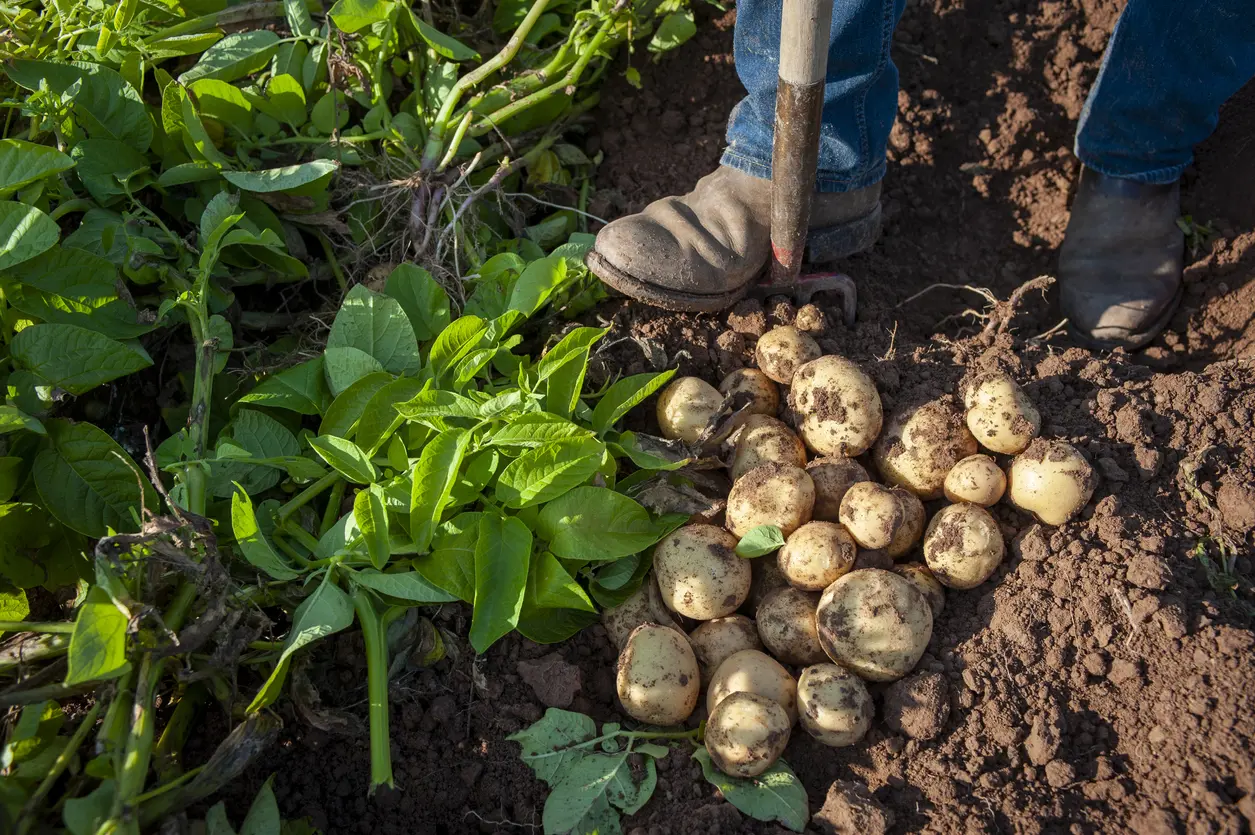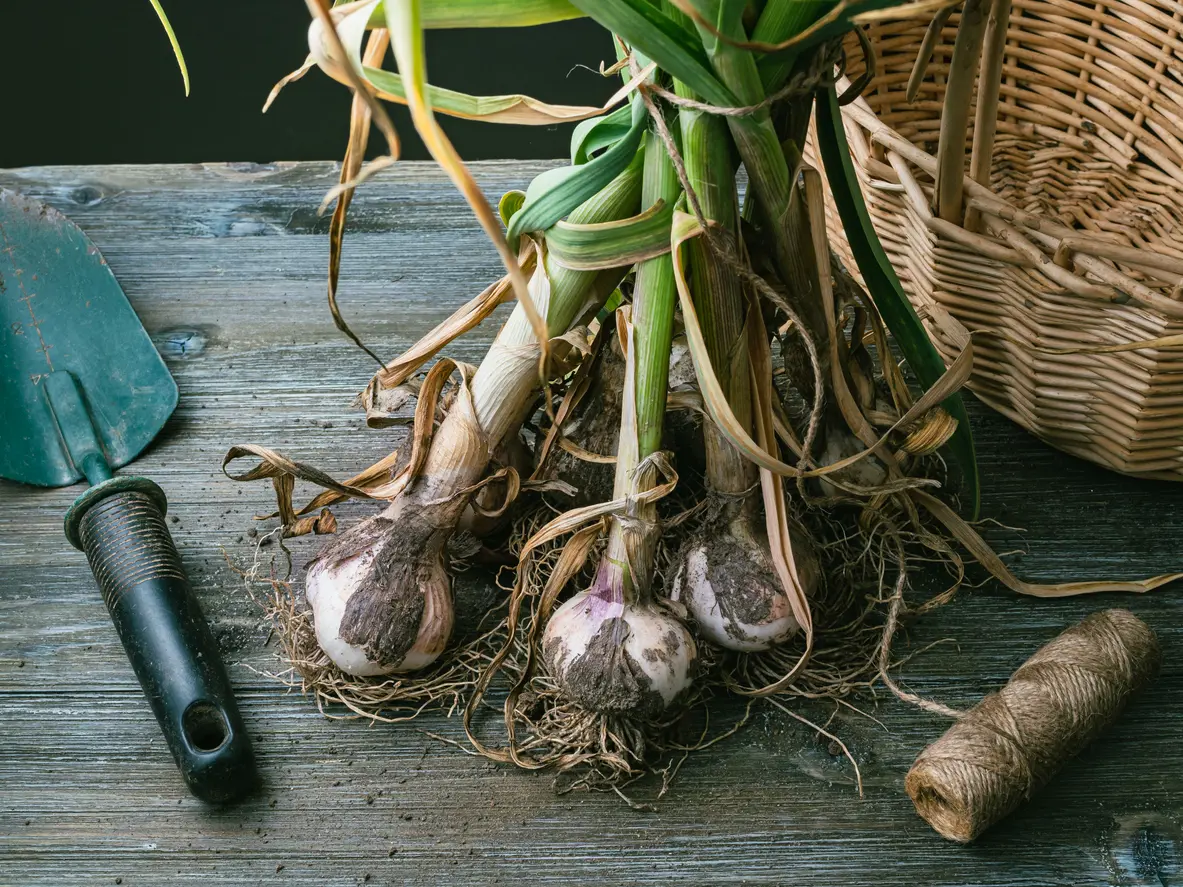
Growing your own food is rewarding on so many levels. This is even true as the weather gets cooler in the fall. It’s not just the chance to enjoy the crisp autumn air—it’s time to choose your fall vegetables to plant! Fall garden vegetables are not only delicious but also offer health benefits. Wondering what the best vegetables to grow in autumn are?
Read on for our picks for cool-season vegetables and some prime fall gardening tips!
1. Kale
Kale is a great choice for gardeners of all experience levels. Kale is a form of “hard” leafy green, and can even be harvested after it has been frozen! Kale plants will even put out new leaves after frost. [1] University of Minnesota Extension, Growing collards and kale in home gardens, 2022. For a fall crop, you’ll want to seed your kale about three months before the first frost date.
You can harvest kale at any time, taking single leaves and allowing the plant to continue to grow, or by cutting the entire plant.
2. Spinach
Spinach is another cold-weather-loving leafy crop. Spinach grows best from fresh seed, so double-check the date on your seed packet! Get spinach seeds in the ground about 6 to 8 weeks before the average first frost date in your area.
Spinach germinates best in cool soil, so you may want to use a shade cloth when the plants are young and the weather is still warm.
3. Lettuce
Lettuce isn’t quite as cold-hardy as kale or spinach, but it is still doable in your fall garden. Plus, there’s a decreased risk of the bitterness brought about by summer heat. [2] Utah State University, How to grow lettuce in your garden, 2020 Choose a variety that is early-maturing, and plant it so that it will be ready to harvest about 1 to 2 weeks before your first frost.
Lettuce loses its texture and flavor after a hard frost, but will tolerate some light frosting.
4. Arugula
Are you running behind in preparing your fall garden? Arugula to the rescue! This fast-growing leafy green matures quickly and is best harvested when it is young. Peppery in flavor, harvest it when the leaves are 2 to 3 inches in length.
It will keep growing in cool fall weather, though it requires protection in temperatures below freezing, such as with a cold frame or frost cloth.
5. Radishes
Plant your fall radishes 5 to 10 weeks before your first expected frost date (check the seed packet of your chosen variety to determine how long they take to mature; some varieties mature in as little as 25 days, while others require more time).
Depending on your location, you can leave your radishes in the ground into early winter and harvest as you need them. But you’ll want to ensure you’ve completed your harvest before temperatures drop below 20 degrees. [3] Southern Exposure Seed Exchange, Growing, storing, and using fall radishes. 2020.
6. Carrots
Like radishes, carrots can be kept safe in the ground into the winter. Just protect them from freezing with a heavy layer of mulch, such as straw. Carrots do well in the ground or in a raised bed. They don’t transplant well, so plant your carrot seeds directly, 10 to 12 weeks before the first frost.
Most carrot varieties take 65 to 75 days to reach maturity.
7. Beets
Beets are semi-hardy, withstanding mild frosts, though they don’t enjoy freezing weather. If you are harvesting for beet roots rather than greens, they are a little more tolerant as the winter chill approaches, and you have a little more time in the garden. You can expect to harvest beet roots 50 to 60 days after planting, though you will see greens pop at 10 to 15 days. Plan accordingly for your fall crop.
Soaking your beet seeds in warm water for 24 hours before planting has been shown to aid in germination. [4] University of Maryland Extension, Growing beets in a home garden, 2023.
8. Turnips
Turnips are one of the best fall crops because they get sweeter after a touch of frost! The conversion of starch into sweeter sugars is actually a cold-protection measure by the plant, but we benefit from it.
As is the case with beets, the roots are a bit more cold-tolerant than the tops, so time your planting appropriately as you consider first frost dates.
9. Broccoli
Like turnips, you’ll find your fall broccoli sweeter and quite tender! You may even find that you get better harvest yields from your fall crop, though it may be a little slower to mature. [5] University of Maryland Extension, Growing broccoli in a home garden, 2023 Expect at least 65 days to maturity for fall broccoli. Broccoli is known as a heavy feeder, requiring good soil nutrition.
Test your soil in advance of planting to determine what, if any, amendments could maximize your broccoli harvest.
10. Cauliflower
Heat-intolerant cauliflower loves fall planting! Expect 75 to 90 days to maturity if planting seeds, a little less if you transplant seedlings. Cauliflower requires a lot of space, so make sure to leave 18 to 24 inches between your plants and rows. Harvest once the head is about eight inches across.
The plants can tolerate light frosts, and in a warmer area, you can harvest well into the winter.
11. Brussels Sprouts
Brussels sprouts have a long planting to harvest window (as long as 125 days!), but that’s no problem because they love the fall weather! They do fine in temperatures as low as 20 degrees without damage, and, like turnips, they get sweeter as the mercury drops.
In southern latitudes, they can even be overwintered completely.
12. Cabbage
Cabbage is a great choice for the fall garden, as it is less susceptible to common diseases as the weather cools. [6] University of Georgia Extension, Homegrown cabbage, 2024 Plant in August or September for a fall crop, because cabbage will tolerate light frost but not heavy freezes. Harvested cabbages can be stored in the refrigerator for about four months.
13. Swiss Chard
For fall chard, choose an early-maturing variety, and plant your seeds so that you will be harvesting 2 to 3 weeks before the first frost in your area. While chard prefers cool weather, it does not tolerate a winter freeze! You can buy a little more time for a continuous harvest by using a row cover during early frosts.
14. Mustard Greens
Mustard greens are another rapid producer you can plant when the gardening season is growing short. In fact, fall-planted mustard is often of higher quality, allowing it to mature under cooler conditions. Plant your mustard so that you can harvest 2 to 3 weeks after the first anticipated frost. Harvest leaves anytime before the seed stalk forms.
15. Collard Greens
Collards are similar to kale in their growing requirements. They will continue producing until freezing temperatures persist. Plant your collards closer together if you plan to harvest smaller leaves, or further apart to harvest whole plants or big leaves.
16. Garlic
While garlic isn’t harvested in the fall (it’s typically ready in the mid-late summer), fall is the time to get the jump on next year’s garlic crop. Fall-planted garlic tends to produce larger bulbs than that planted in the spring, as it utilizes the winter to establish itself underground.
When you get your cloves in the ground will vary depending on your location and frost dates, but generally, September to November is a good guideline.
17. Onions
Just like garlic, certain varieties of onions do well when planted and allowed to grow over the winter season for a bountiful harvest the following year. Perennial or “multiplier-type” onions are best suited for fall planting. Plant them pointed end up and cover with an inch of soil. If you are in an area with especially cold winters, protect your onions with a healthy layer of mulch on top.
As a bonus, this will protect them from the first spring weeds!
18. Peas
Though typically considered an early spring favorite, peas are also a delicious addition to the fall garden. Plant your fall crop of peas about six weeks before the first predicted frost, and expect a harvest in about 50 days.
Peas are most hardy when directly sown, and aren’t partial to transplanting.
19. Kohlrabi
Kohlrabi loves cool weather and takes about two months to mature. Plant in late July, and in most areas, you’ll be able to harvest your bulbs before a hard freeze arrives. A row cover can help shade the young plants while the summer heat still rages.
For the best results, avoid planting kohlrabi where related crops like broccoli, cauliflower, and cabbage have recently been grown, and harvest the bulbs when they reach 2 to 3 inches in width. If they get too big, they are woody and tough!
20. Pak Choi
Pak choi, also known as bok choy, is from the same family as kohlrabi. It prefers to avoid soil where its relatives have been planted in recent years. Pak choi takes about two months from seed to harvest, so late July is generally a good time to plant for a fall harvest.
Harvest your plants when the heads feel firm when pressed. If they’re loose, give them a little more time to mature.
Bonus: Fall Gardening Tips
Should I start seeds or transplant?
The good news is, most of the plants we’ve discussed grow well directly from seed, saving you the time it takes to grow and transplant starts. However, growing transplants inside, protected from the summer heat, can give you a head start for an earlier harvest if you have a variety that needs a few extra weeks. Keep in mind that some plants, like carrots, hate transplanting at all.
Frost protection
Since some of our fall garden crops can tolerate light frosts but not heavy ones, it is important to have a plan for frost protection if your produce isn’t quite ready to harvest and you find out a freeze is on the way. Tools like cold frames, row covers, thick mulch (such as straw), and even protective blankets are great options to have on hand.
Think about the measures you take to keep your young plants safe when an unanticipated late spring frost comes along, and apply them to your fall plants.
Companion planting
Some fall vegetables absolutely hate being planted where relatives recently grew, while others love some company! Plants that complement one another while growing are known as companion plants. For example, radishes do well with carrots, peas, or spinach, while lettuce is friends with onions.
Was this article helpful?
-
University of Minnesota Extension, Growing collards and kale in home gardens, 2022.;
https://extension.umn.edu/vegetables/growing-collards-and-kale -
Utah State University, How to grow lettuce in your garden, 2020;
https://extension.usu.edu/yardandgarden/research/lettuce-in-the-garden -
Southern Exposure Seed Exchange, Growing, storing, and using fall radishes. 2020.;
https://blog.southernexposure.com/2020/09/growing-storing-using-fall-radishes/ -
University of Maryland Extension, Growing beets in a home garden, 2023. ;
https://extension.umd.edu/resource/growing-beets-home-garden/ -
University of Maryland Extension, Growing broccoli in a home garden, 2023;
https://extension.umd.edu/resource/growing-broccoli-home-garden/ -
University of Georgia Extension, Homegrown cabbage, 2024;
https://secure.caes.uga.edu/extension/publications/files/pdf/C%201218_2.PDF






